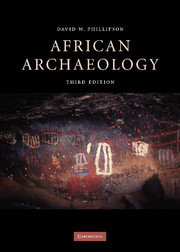Book contents
- Frontmatter
- Contents
- List of illustrations
- Sources of illustrations
- Preface
- 1 Introduction
- 2 The emergence of humankind in Africa
- 3 The consolidation of basic human culture
- 4 Regional diversification and specialisation
- 5 The beginnings of permanent settlement
- 6 Early farmers
- 7 Iron-using peoples before AD 1000
- 8 The second millennium ad in sub-Saharan Africa
- Bibliographic guide
- Bibliographic references
- Index
4 - Regional diversification and specialisation
Published online by Cambridge University Press: 05 June 2012
- Frontmatter
- Contents
- List of illustrations
- Sources of illustrations
- Preface
- 1 Introduction
- 2 The emergence of humankind in Africa
- 3 The consolidation of basic human culture
- 4 Regional diversification and specialisation
- 5 The beginnings of permanent settlement
- 6 Early farmers
- 7 Iron-using peoples before AD 1000
- 8 The second millennium ad in sub-Saharan Africa
- Bibliographic guide
- Bibliographic references
- Index
Summary
The ‘Middle Stone Age’ and the ‘Late Stone Age’
Developments throughout Africa from rather more than 250,000 until about 10,000 years ago show an accelerated shift away from broad cultural uniformities towards the establishment of increasingly distinct regional traditions. These trends may most readily be traced in the archaeological record by study of stone-artefact typology; but it is sometimes possible to go beyond such investigations in an attempt to illuminate the nature of the ancient societies which, to an increasing extent, may be seen as ancestral to recent African populations. Despite this growing diversity, developments seem to have followed roughly parallel courses with inherent continuity in different parts of Africa and, indeed, in other regions of the Old World (J. G. D. Clark 1977). The reasons for this are not yet fully understood, and the various stages were not necessarily reached at the same time in different areas. In recent years, the study of the earlier part of this period has received increased international attention because of the realisation that it may have been particularly important in the physical and cultural development of modern people.
The period with which this chapter is concerned has conventionally been divided by archaeologists of sub-Saharan Africa into the ‘Middle Stone Age’ and the ‘Late Stone Age’. As research has progressed, it has become apparent that there was no sharp divide between these, any more than there was between industries of the so-called Middle Stone Age and their predecessors; the distinctions have become increasingly hard to define on other than arbitrary grounds.
- Type
- Chapter
- Information
- African Archaeology , pp. 91 - 146Publisher: Cambridge University PressPrint publication year: 2005
- 1
- Cited by



